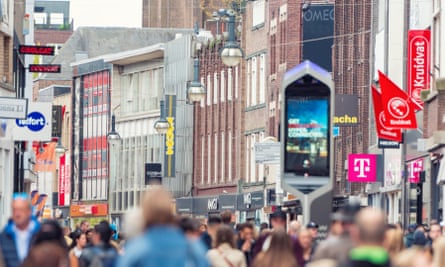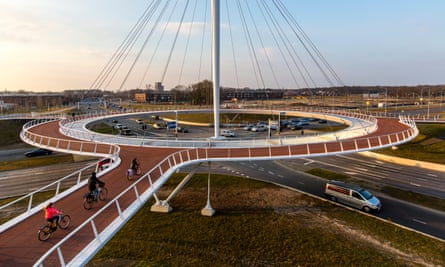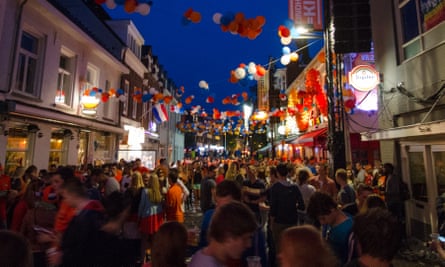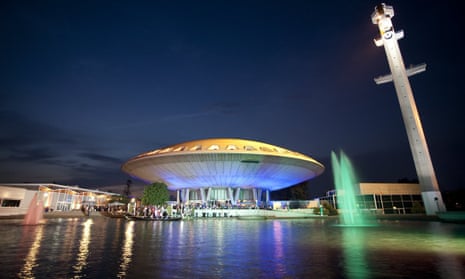Like a patissier guiding a giant icing nozzle, Theo Salet builds up layer upon layer of greyish goop. He’s not making a cake, though – this Eindhoven University of Technology professor is perfecting a technique to build the world’s first concrete 3D-printed home.
It seems barely a month goes by without news of an urban innovation in the Dutch city. From Salet’s 3D-printed housing scheme of five Stonehenge-like houses, to the creation of the Brainport “smart district” to test technology and community initiatives, to a “living lab” of cameras, lights and microphones for crowd experiments on the popular nightlife street Stratumseind, Eindhoven wants to be a place where the future is already on trial.
It wasn’t always this way. Yasin Torunoğlu, deputy mayor for housing, districts and participation, says the city’s drive for innovation stems from the early 90s when two dominant employers disappeared: Daf went bust and Philips moved manufacturing to China. “Dismissal letters fell through the letter boxes like advertisements,” he says. “That was a really tough period. Then the mayor and the heads of the chamber of commerce and the university said they needed to combine their powers.”
They set up a stimulation fund based on “triple helix” collaboration between government, business and knowledge institutions to attract new firms. “That’s where [our] Brainport idea came from, so we weren’t dependent on two or three factories but constantly working on social issues that provided business and jobs,” he says. “We’ve become the city where knowledge-intensive companies base themselves and combine with designers: we have the nerds and the hippies.”
Now the city’s population of 227,000 people more than doubles during the annual Dutch Design Week, startups and homes have filled former Philips buildings in the Strijp R district, and there’s a thriving international community. In 2017, according to the CBS Dutch national statistics office, 22.6% of the Netherlands’ population of 17 million were first- or second-generation immigrants. In Eindhoven, the figure was 33.5%.
But while all this sounds like a model of progressive urban life, is living in a centre of innovation a walk in the park (tech-aided, of course), or do some citizens dislike being under the microscope?

A recent court case suggests Eindhoven is not utopia. The city has been working with its University of Technology (TU) and ENS Clean Air to test a system that charges and extracts fine particles from the air.
“The best application is a tunnel,” says Prof Bert Blocken, chair of building physics at Eindhoven TU. “There you get the highest concentrations of air pollution, then a parking garage, and then a very narrow street with high-rise buildings on the side where air pollution accumulates. If you take that out, you will really make a difference to the life of all the people living downwind.”
The plan was to try a full-scale test of 30 fans, but this ran into problems when a Q-Park garage changed its mind about hosting them. Undeterred, the researchers built a tent above the garage’s vents to capture its air. The garage then changed the direction of its ventilation system, and all this has ended in a court order forcing the garage to keep its fans blowing into the test tent until calibrations are complete.
The saga demonstrates that even in a city that wants to make smart innovation its USP, there are both upsides and downsides for local businesses and residents.
“You don’t want to come home at night and find out that the municipality has built a tent over your front garden!” says Q-Park’s national managing director, Mark van Haasteren, lightly.

That said, even van Haasteren is a fan of what he calls a “very active and progressive city” where the municipality collaborates with university and businesses to improve city life.
But there are other issues too. Prof Elphi Nelissen, Eindhoven TU’s chair of building sustainability, is working on the Brainport smart district, which will house about 3,000 people in 1,500 homes and cost more than €500m (£440m). She points out that data use is a big issue.
“Data protection is one of the main things where we have to be as clear as possible,” she says. “We want to have an open data platform where all companies can take data out. The people who live in the district can decide to share their anonymised data or not. If they share it, they benefit, maybe financially or with better services.”
She says the project needs to build in an extra €100m budget for ongoing research and to “insure the people that live there, so if we make mistakes, we repair things we have done”.

Monique Mols, head of public affairs at chip machine maker ASML – a successful Philips spinoff – adds that while its high-level jobs provide employment in the manual supply chain and service industries, fast growth does bring “growing pains”.
“Housing prices are going up ... especially in an area like Brainport Eindhoven, where a lot of people move as it’s a job engine,” she says. “We look at housing, the facilities in the area and whether we are attractive enough to keep all these people in: we are actively working on that.”
And what does Joe Public think? Stan Dooman, a barman for the last two years at the Tipsy Duck Pub on Stratumseind, is cautiously enthusiastic about on-street monitoring systems, to reduce problems: “There’s a lot of people in the same place, so every now and then something happens. I think privacy is important so I’m not so keen on microphones. But in this case it could have a good result.”
Outside, a couple of students working hard on their glasses of beer around the corner from the Lungs of the City experiment, were even more nonchalant. “It has got a lot better for safety,” says 20-year-old Dennis van Leenders. “I don’t mind it. It’s just Eindhoven.”
Follow Guardian Cities on Twitter, Facebook and Instagram to join the discussion, and explore our archive here

Comments (…)
Sign in or create your Guardian account to join the discussion